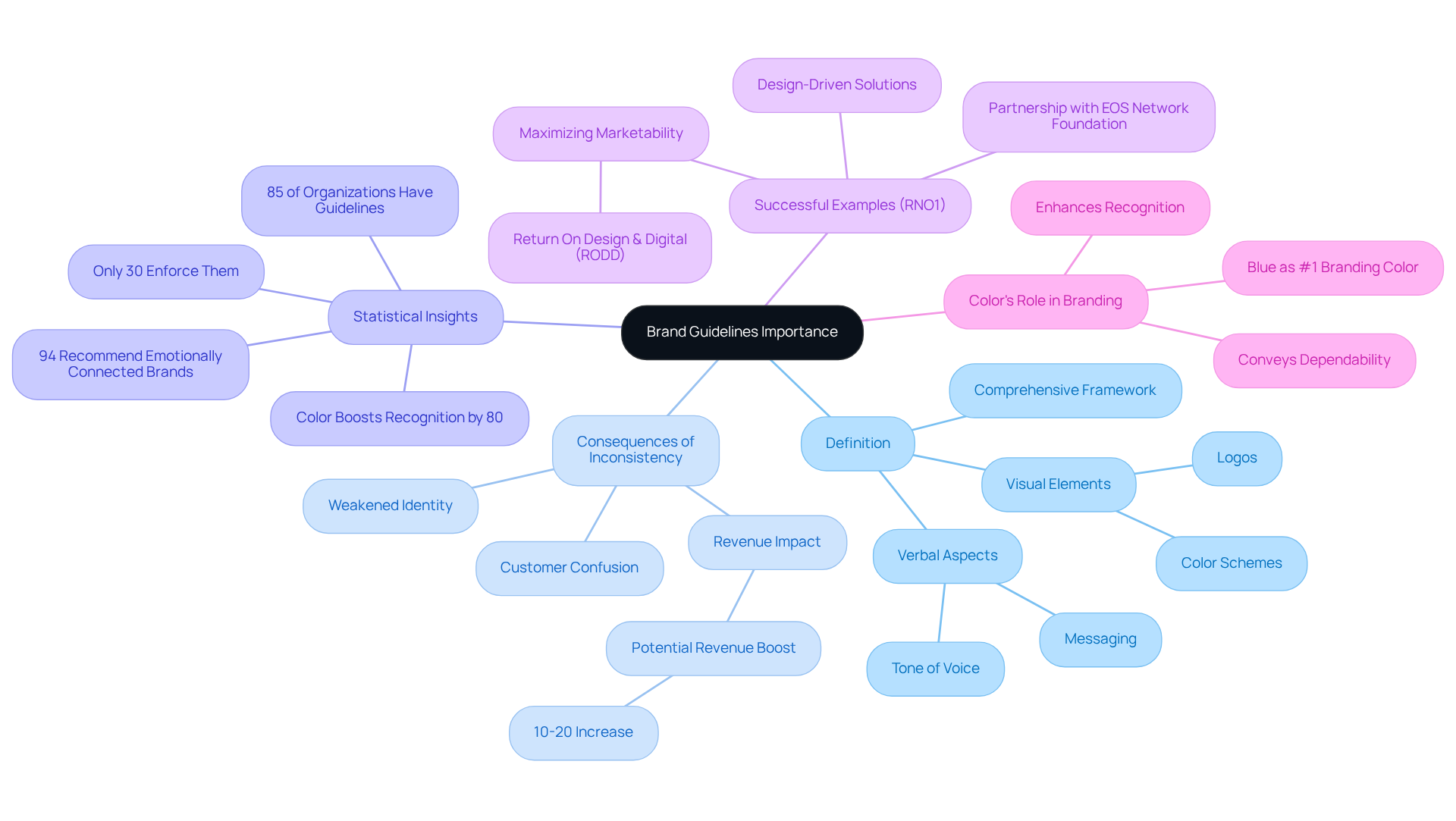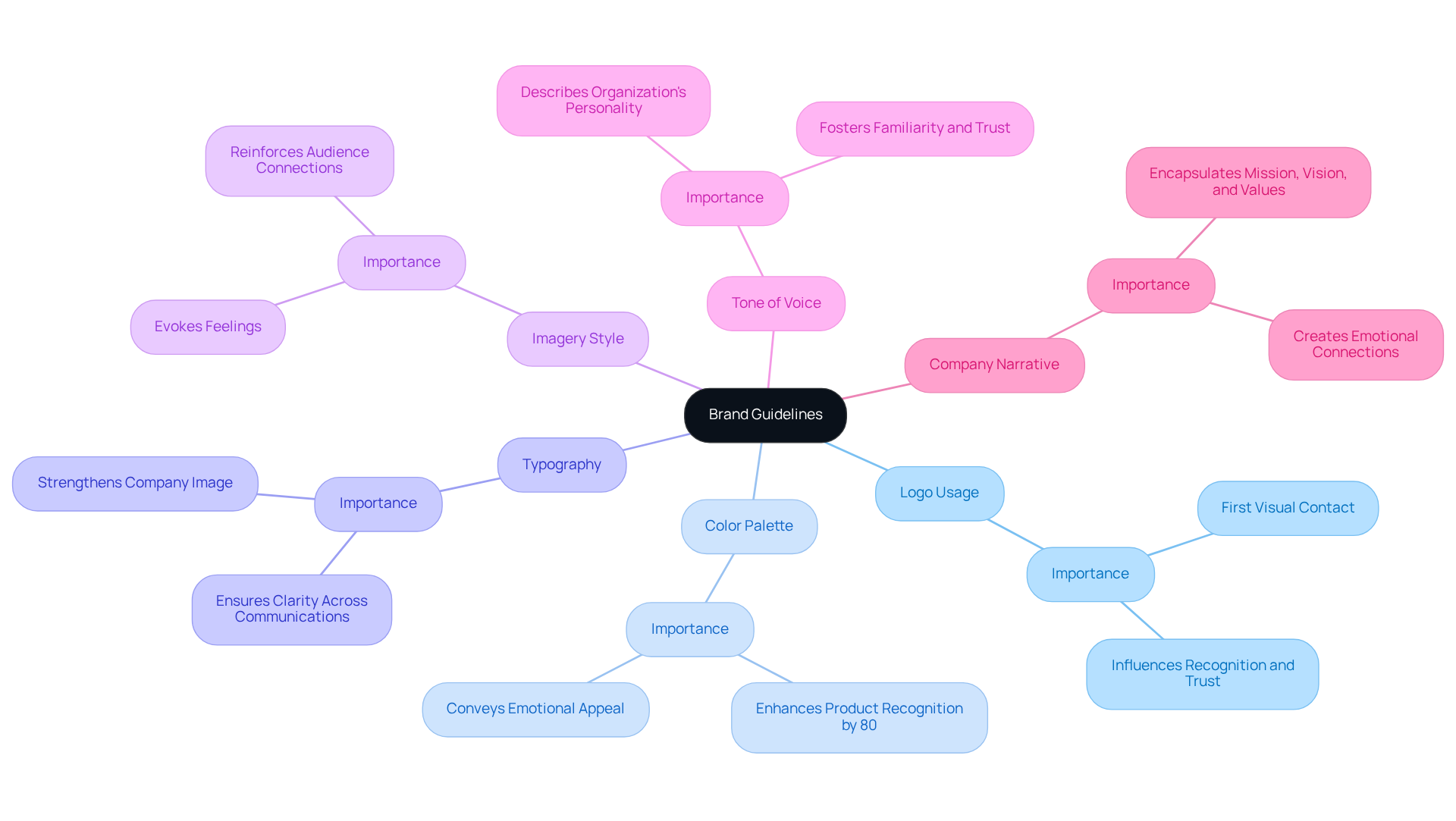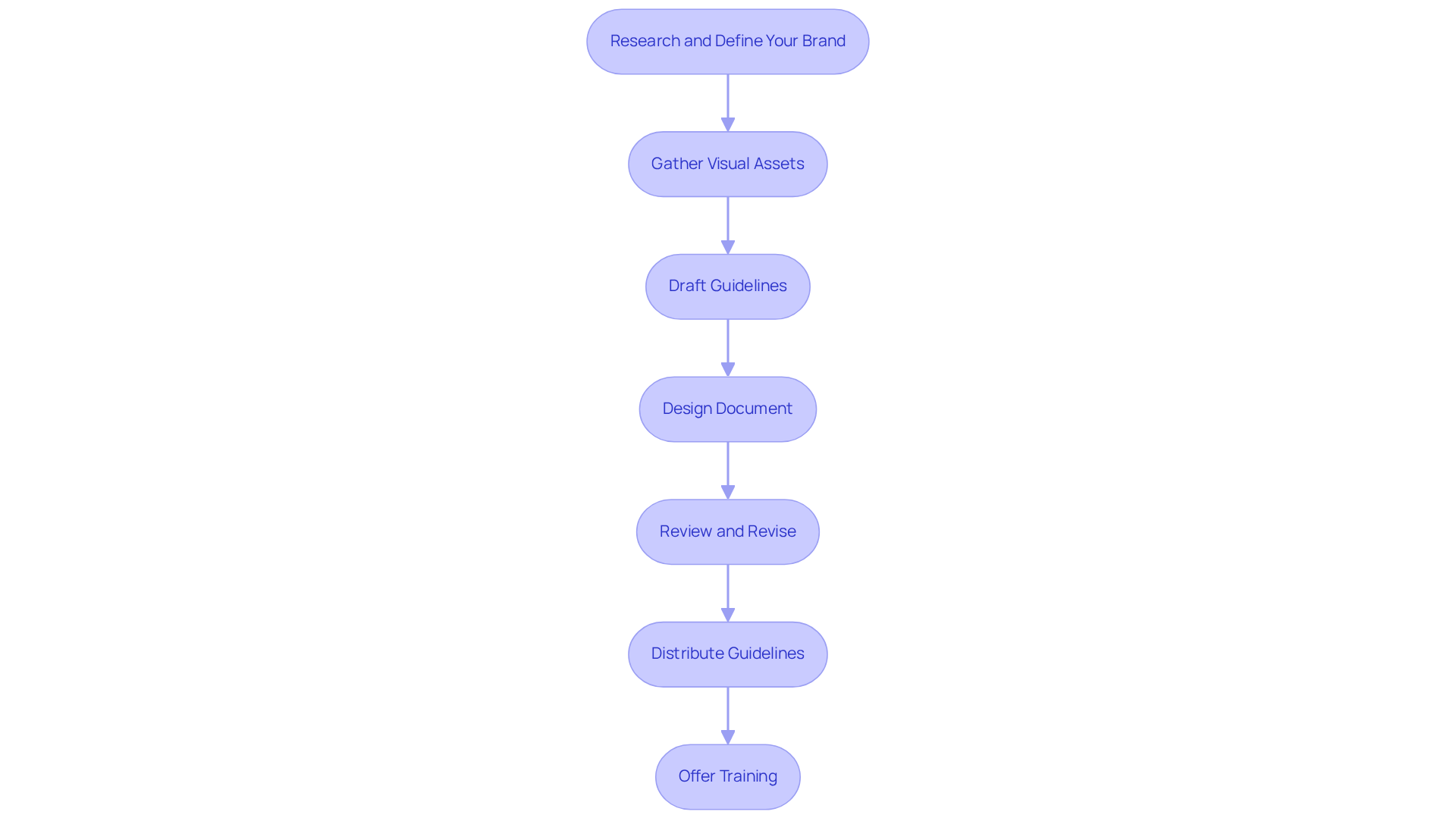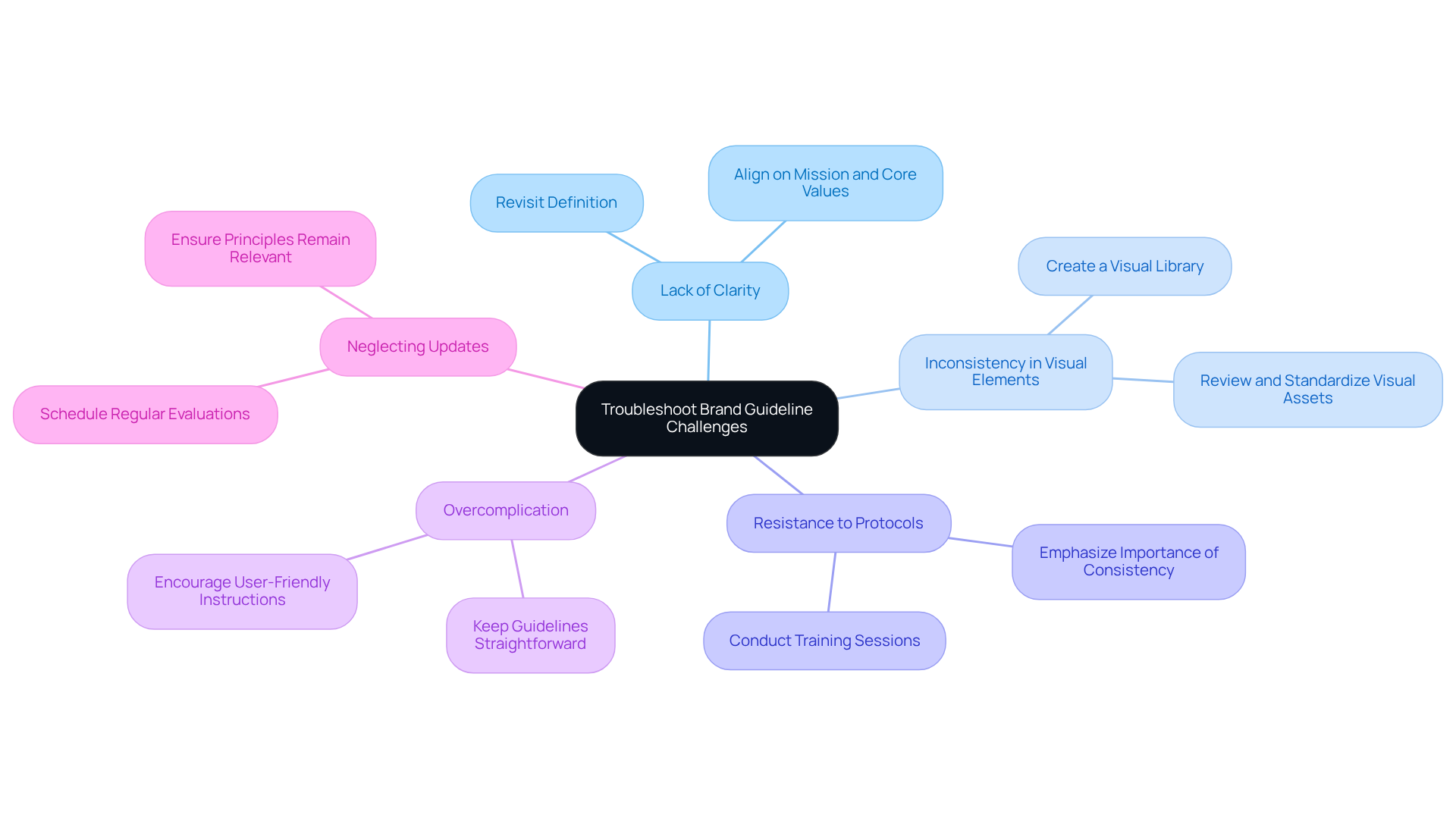Overview
Navigating the world of branding can be daunting for startups. Many founders grapple with the challenge of defining their brand and establishing a cohesive identity that resonates with their audience. This uncertainty can lead to inconsistencies that hinder market presence and customer loyalty, creating a sense of frustration and doubt. However, there is hope. By following a structured approach to creating brand guidelines, startups can transform their challenges into opportunities for growth.
Imagine starting with thorough research to truly understand your brand's essence. Gathering visual assets that reflect your mission and values becomes a collaborative journey, bringing your team closer together. Drafting comprehensive guidelines not only clarifies your vision but also empowers your team to embody your brand consistently. Training them ensures that everyone is on the same page, fostering a unified front that your customers can trust.
By embracing this clear, step-by-step process, startups can enhance their market presence and cultivate customer loyalty. This nurturing approach not only leads to increased revenue but also elevates brand recognition in a competitive landscape. Remember, you are not alone in this journey; with the right support and guidance, your startup can thrive and make a meaningful impact.
Introduction
Establishing a strong brand identity presents a significant challenge for tech startups. The risk of inconsistency can lead to confusion among customers and a loss of trust. It's disheartening to see passionate founders struggle with this aspect, as effective brand guidelines are essential. These guidelines provide a vital framework, ensuring that every visual and verbal element aligns with the company's core values and mission.
Yet, many startups find themselves grappling with the complexities of crafting these guidelines, often missing out on valuable opportunities to connect with their audience. What steps can emerging companies take to navigate these challenges? How can they forge a compelling brand presence that captures their audience's loyalty?
By sharing experiences and insights, we can work together to build a supportive community that empowers tech startups on their branding journey.
Define Brand Guidelines and Their Importance
For many tech startups, establishing a clear identity can feel daunting. The problem lies in the inconsistency that often arises when a name is presented across various platforms. This inconsistency can lead to confusion among customers, ultimately weakening a company's identity. In a competitive market, where trust is paramount, it's crucial for startups to convey their values effectively and stand out from the crowd. This is where brand guidelines play a crucial role in establishing identity standards. They serve as a comprehensive framework, guided by brand guidelines, that oversee not just visual elements like logos and color schemes, but also the verbal aspects, including tone of voice and messaging.
The implications of neglecting these standards can be profound. Research indicates that consistent marketing can result in a remarkable revenue boost of 20%. Yet, while 85% of organizations have established identity standards, only 30% actually implement them. This gap presents a for new companies to leverage. Think of successful tech startups, such as those associated with RNO1, which have demonstrated that strong identity standards not only enhance customer trust but also cultivate loyalty. In fact, consumers are 94% more likely to recommend companies they feel an emotional connection with.
Consider RNO1's partnership with the EOS Network Foundation. This collaboration illustrates how impactful branding principles can reshape digital identity and foster meaningful customer interactions. RNO1's commitment to design-driven solutions ensures that these principles are not merely theoretical; they are actively integrated into the branding process. This approach maximizes marketability through Return On Design & Digital (RODD) strategies. Moreover, color plays a vital role in company recognition, enhancing it by 80%, making it an essential component of effective branding strategies.
By prioritizing consistency in their brand guidelines, startups can establish a solid foundation for long-term growth and recognition. Embracing these principles not only helps in establishing a strong presence but also fosters a nurturing environment where customers feel valued and connected. Together, we can navigate the complexities of branding and create a lasting impact.

Identify Essential Elements of Brand Guidelines
Branding can often feel overwhelming for tech startup founders, who are navigating a myriad of decisions that shape their company’s identity. The challenge lies in creating a cohesive brand that resonates with their audience and builds trust. Without , it’s easy to misstep, leading to confusion and a lack of recognition.
Essential elements of brand guidelines can help alleviate this stress by providing a roadmap for success.
- Logo Usage is paramount; it includes clear instructions on how to use the logo, covering size, spacing, and variations. This first visual point of contact significantly influences recognition and trust, making effective logo usage crucial.
- Next is the Color Palette. A defined set of colors that signify the identity, including primary and secondary colors, enhances product recognition by up to 80%. This makes it essential for conveying the right message and emotional appeal.
- Typography also plays a vital role. Guidelines on font choices, sizes, and usage for different contexts ensure clarity across all communications. Consistent typography strengthens the company's image, fostering a sense of familiarity.
- The Imagery Style is equally important. Specifications for photography, illustrations, and iconography should align with the company’s identity. The right imagery can evoke feelings and reinforce connections with the audience, enhancing the overall perception of the company.
- Another key element is the Tone of Voice. This describes the organization’s personality and how it should communicate with its audience. Establishing a consistent tone fosters familiarity and trust, vital for customer loyalty.
- Lastly, the Company Narrative encapsulates the organization’s mission, vision, and values, providing context for all marketing efforts. A compelling narrative creates emotional connections, driving customer engagement and loyalty.
By incorporating these elements, startups can establish a strong framework that guides all branding and marketing efforts in accordance with their brand guidelines. This ensures consistency and effectiveness in their strategy, guiding them toward a successful and supportive branding journey.

Develop a Step-by-Step Process for Creating Brand Guidelines
Creating effective brand guidelines can feel overwhelming, particularly for startup founders who are navigating a competitive landscape. Many struggle with establishing a consistent identity, which can lead to missed opportunities and diminished trust from potential customers. Research shows that a staggering 68% of companies recognize that consistency in their brand identity can contribute to revenue growth of 10% or more. This highlights the importance of a strong presence in the market.
To begin, it’s essential to research and define your brand. Take the time to understand your target audience, competitors, and market trends. Clearly articulating your organization’s mission, vision, and values will serve as a solid foundation for your branding efforts. Remember, 55% of first impressions are shaped by visual perspectives, so this foundational knowledge is crucial.
Next, gather your visual assets. Collect logos, color palettes, and typography that reflect your company’s image. Ensuring these elements align with your brand identity is vital for making a lasting impression.
Once you have your assets, draft the guidelines. Compose your brand guidelines clearly and concisely to facilitate understanding and implementation. Effective branding not only enhances recognition but can also lead to improved sales and lower advertising costs.
Design the document to be visually appealing, showcasing your identity through the use of your color palette and typography. A consistent brand presentation is key to building trust and loyalty among your audience.
After drafting, review and revise the guidelines. Share the draft with stakeholders and encourage their feedback. This collaborative process can lead to a more robust framework, ensuring clarity and comprehensiveness. Involving others fosters a sense of ownership and acceptance of the guidelines.
Finally, distribute the guidelines and offer training to your team. This step is crucial, as 85% of companies have , yet only 30% implement them effectively. As Ana Gajić wisely states, "Get those values aligned to foster strong connections and loyalty with your customers."
By following this organized approach, startups can create identity standards that are thorough yet simple to execute, promoting a strong identity presence in the competitive tech environment. Remember, you’re not alone in this journey—many have walked this path and found success by prioritizing their brand identity.

Troubleshoot Common Challenges in Brand Guideline Creation
Establishing identity standards can be quite challenging for many startups. It’s important to recognize these difficulties and approach them with care. Here are some common issues along with supportive strategies to help you navigate them:
- Lack of Clarity: When team members feel uncertain about the organization’s essence, it’s crucial to revisit the definition. It’s essential that everyone aligns on the mission and core values. In fact, 69% of companies report that identity guidelines aren’t widely adopted or simply don’t exist. Moreover, 64% of consumers expect companies to understand their needs and help them find suitable products, highlighting the importance of clarity in identity.
- Inconsistency in Visual Elements: Inconsistencies can be frustrating. To address this, review and standardize all visual assets. Creating a visual library that team members can easily consult is a great step forward. Remember, products shown consistently are 3 to 4 times more likely to gain visibility, which can truly enhance your brand’s presence.
- Resistance to Protocols: It’s not uncommon to face pushback from team members regarding compliance with protocols. Conducting training sessions can help emphasize the importance of consistency and its benefits for the brand. It’s worth noting that 70% of survey respondents believe consistent branding is crucial for effectively communicating with existing customers.
- Overcomplication: It’s easy to fall into the trap of creating overly intricate instructions. Keeping guidelines straightforward and user-friendly encourages adherence. Effective branding creates lasting impressions, and simplicity can significantly enhance understanding.
- Neglecting Updates: As brands evolve, so too should their standards. Scheduling regular evaluations ensures that your principles remain relevant and effective. This proactive approach can greatly improve team alignment and strengthen corporate identity.
By addressing these challenges with empathy and foresight, startups can create brand guidelines that are not only effective but also embraced by their teams. Remember, you’re not alone in this journey; many have faced similar hurdles and emerged stronger. Together, let’s create a where your brand can thrive.

Conclusion
Establishing effective brand guidelines can feel like a daunting task for startups striving to create a unique identity in a bustling marketplace. This challenge often leads to uncertainty, as inconsistency can undermine trust and loyalty among customers. However, by prioritizing clear branding standards, startups can not only communicate their core values but also foster meaningful connections with their audience, ultimately paving the way for growth and recognition.
Throughout this article, we’ve explored the essential elements of brand guidelines, such as:
- Logo usage
- Color palettes
- Typography
- Imagery style
- Tone of voice
- The company narrative
Each of these components plays a vital role in shaping a cohesive brand identity that resonates deeply with the target audience. We also outlined a structured step-by-step process for creating these guidelines, emphasizing the importance of research, collaboration, and ongoing evaluation to navigate the common challenges encountered along the way.
In a competitive business landscape, the importance of robust brand guidelines cannot be overstated. We encourage startups to embrace these principles, not only to enhance their market presence but also to cultivate an environment where customers feel valued and engaged. By investing in a strong branding foundation, startups can position themselves for long-term success and the potential to make a lasting impact in their industry. Remember, you are not alone in this journey; many have faced similar challenges and emerged stronger. Together, let’s build a community where your brand can thrive.
Frequently Asked Questions
What are brand guidelines and why are they important for tech startups?
Brand guidelines are a comprehensive framework that establish identity standards for a company, covering both visual elements (like logos and color schemes) and verbal aspects (such as tone of voice and messaging). They are important for tech startups to maintain consistency across various platforms, convey their values effectively, and stand out in a competitive market.
What are the consequences of neglecting brand guidelines?
Neglecting brand guidelines can lead to inconsistency, which may confuse customers and weaken a company's identity. Research shows that consistent marketing can boost revenue by 20%. Despite 85% of organizations having identity standards, only 30% implement them, presenting an opportunity for startups to differentiate themselves.
How do strong brand guidelines affect customer trust and loyalty?
Strong brand guidelines enhance customer trust and foster loyalty. Consumers are 94% more likely to recommend companies with which they feel an emotional connection, highlighting the importance of effective branding.
Can you provide an example of successful branding in action?
An example is RNO1's partnership with the EOS Network Foundation, which demonstrates how impactful branding principles can reshape digital identity and enhance customer interactions. RNO1 integrates design-driven solutions into their branding process, maximizing marketability through Return On Design & Digital (RODD) strategies.
What role does color play in branding?
Color significantly impacts company recognition, enhancing it by 80%. It is a crucial component of effective branding strategies, helping to establish a memorable identity.
How can startups benefit from prioritizing brand guidelines?
By prioritizing consistency in their brand guidelines, startups can create a solid foundation for long-term growth and recognition. This approach fosters a nurturing environment where customers feel valued and connected, ultimately leading to a lasting impact in the market.




